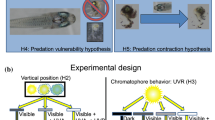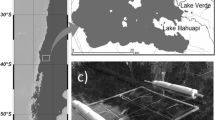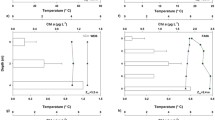Abstract
Selection pressure induced by simultaneously occurring environmental threats is a major evolutionary driver for organisms in terrestrial, as well as in aquatic ecosystems. For example, protection against ultraviolet radiation (UVR) and predation include both morphological and behavioral components. Here we address those selective pressures on zooplankton by performing a latitudinal monitoring, combined with mechanistic experiments in the Antarctic Southern Ocean, where the UVR-threat is extremely high. We assessed vertical distributions of zooplankton along the Antarctic coast showing that animals were most abundant at 20–80 m and tended to avoid the surface at sites with clear water. UVR-threat disappeared at between 9 and 15 m at sites with low and high water transparency, respectively. Light levels were, however, sufficient for visual fish predation down to approximately 19 and 37 m, respectively. The few zooplankton that were present in surface waters had high levels of non-pigmented UVR-protective compounds (mycosporine-like amino acids) compared to deeper dwelling zooplankton. Overall they had low levels of red pigmented UVR-protective compounds (carotenoids), suggesting high predation on pigmented individuals. In a complementary laboratory study we showed that levels of UVR-protective compounds increased considerably when zooplankton were exposed to UVR in the absence of predator cues. The recently developed transparency-regulator hypothesis predicts that UVR avoidance is an important driver to diel vertical migration in transparent waters, such as in Antarctica. We, however, conclude that copepods resided well below the level where UVR had diminished to very low levels and that predator avoidance or food availability are more likely drivers of zooplankton vertical depth distribution in transparent marine systems.







Similar content being viewed by others
Explore related subjects
Discover the latest articles and news from researchers in related subjects, suggested using machine learning.References
Aksnes DL, Utne ACW (1997) A revised model of visual range in fish. Sarsia 82:137–147
Asaeda T, Park BK, Manatunge J (2002) Characteristics of reaction field and the reactive distance of a planktivore, Pseudorasbora parva (Cyprinidae), in various environmental conditions. Hydrobiologia 489:29–43
Ban S, Ohi N, Leong SCY, Takahashi KT, Riser CW, Taguchi S (2007) Effect of solar ultraviolet radiation on survival of krill larvae and copepods in Antarctic Ocean. Polar Biol 30:1295–1302
Batty RS, Blaxter JHS, Libby DA (1986) Herring (Clupea harengus) filter-feeding in the dark. Mar Biol 91:371–375
Bollens SM, Frost BW (1990) UV light and vertical distribution of the marine planctonic copepod Acartia hudsonica Pinhey. J Exp Mar Biol Ecol 137:89–93
Boysenennen E, Hagen W, Hubold G, Piatkowski U (1991) Zooplankton biomass in the ice-covered Weddell Sea, Antarctica. Mar Biol 111:227–235
Browman HI, Rodriguez CA, Beland F, Cullen JJ, Davis RF, Kouwenberg JHM, Kuhn PS, McArthur B, Runge JA, St-Pierre JF, Vetter RD (2000) Impact of ultraviolet radiation on marine crustacean zooplankton and ichthyoplankton: a synthesis of results from the estuary and Gulf of St. Lawrence, Canada. Mar Ecol Prog Ser 199:293–311
Cisewski B, Strass VH, Rhein M, Kragefsky S (2010) Seasonal variation of diel vertical migration of zooplankton from ADCP backscatter time series data in the Lazarev Sea, Antarctica. Deep Sea Res Part I Oceanogr Res Pap 57:78–94
Cohen RE, Lough RG (1981) Length-weight relationships for several copepods dominant in the Georges Bank-Gulf of Maine area. J Northwest Atl Fish Sci 2:47–52
Confer JL, Howick GL, Corzette MH, Kramer SL, Fitzgibbon S, Landesberg R (1978) Visual predation by planktivores. Oikos 31:27–37
Fiksen O (1997) Allocation patterns and diel vertical migration: modeling the optimal Daphnia. Ecology 78:1446–1456
Froneman PW, Pakhomov EA, Perissinotto R, McQuaid CD (2000) Zooplankton structure and grazing in the Atlantic sector of the Southern Ocean in late austral summer 1993—Part 2. Biochemical zonation. Deep Sea Res Part I Oceanogr Res Pap 47:1687–1702
García PE, Pérez AP, Diéguez MDC, Ferraro MA, Zagarese HE (2008) Dual control of the levels of photoprotective compounds by ultraviolet radiation and temperature in the freshwater copepod Boeckella antiqua. J Plankton Res 30:817–827
Goodwin TW (1986) Metabolism, nutrition, and function of carotenoids. Annu Rev Nutr 6:273–297
Hairston NG (1979) The adaptive significance of color polymorphism in two species of Diaptomus (Copepoda). Limnol Oceanogr 24:15–37
Hansson L-A (2004) Plasticity in pigmentation induced by conflicting threats from predation and UV radiation. Ecology 85:1005–1016
Hansson L-A, Hylander S (2009) Effects of ultraviolet radiation on pigmentation, photoenzymatic repair, behavior, and community ecology of zooplankton. Photochem Photobiol Sci 8:1266–1275
Hansson L-A, Hylander S, Sommaruga R (2007a) Escape from UV threats in zooplankton: a cocktail of behavioral and phenotypic traits. Ecology 88:1932–1939
Hansson L-A, Becares E, Fernádez-Aláez M, Fernádez-Aláez C, Kairesalo T, Miracle M, Romo S, Stephen D, Vakkilainen K, van de Bund W, van Donk E, Moss B (2007b) Relaxed circadian rhythm in zooplankton along a latitudinal gradient. Oikos 116:585–591
Hays G (2003) A review of the adaptive significance and ecosystem consequences of zooplankton diel vertical migrations. Hydrobiologia 503:163–170
Helbling EW, Zagarese H (eds) (2003) UV effects in aquatic organisms and ecosystems. Comprehensive series in photochemical and photobiological sciences. The Royal Society of Chemistry, Cambridge
Helbling EW, Zaratti F, Sala LO, Palenque ER, Menchi CF, Villafane VE (2002) Mycosporine-like amino acids protect the copepod Boeckella titicacae (Harding) against high levels of solar UVR. J Plankton Res 24:225–234
Hopkins TL (1985) Food web of an Antarctic midwater ecosystem. Mar Biol 89:197–212
Hylander S (2009) Zooplankton responses to threats from UV and predation. PhD thesis, Lund University, Sweden
Hylander S, Hansson L-A (2010) Vertical migration mitigates UV effects on zooplankton community composition. J Plankton Res 32:971–980
Hylander S, Jephson T (2010) UV protective compounds transferred from a marine dinoflagellate to its copepod predator. J Exp Mar Biol Ecol 389:38–44
Hylander S, Boeing WJ, Graneli W, Karlsson J, von Einem J, Gutseit K, Hansson L-A (2009a) Complementary UV protective compounds in zooplankton. Limnol Oceanogr 54(6):1883–1893
Hylander S, Larsson N, Hansson L-A (2009b) Zooplankton vertical migration and plasticity of pigmentation arising from simultaneous UV and predation threats. Limnol Oceanogr 54:483–491
Hylander S, Souza MS, Balseiro E, Modenutti B, Hansson L-A (2012) Fish-mediated trait compensation in zooplankton. Funct Ecol 26:608–615
Jarman S, Elliott N, Nicol S, McMinn A, Newman S (1999) The base composition of the krill genome and its potential susceptibility to damage by UV-B. Antarct Sci 11:23–26
Johnsen G, Jacobsen PJ (1987) The effect of food limitation on vertical migration in Daphnia longispina. Limnol Oceanogr 32:873–880
Johnsen S, Widder EA (2001) Ultraviolet absorption in transparent zooplankton and its implications for depth distribution and visual predation. Mar Biol 138:717–730
Karentz D, McEuen FS, Land MC, Dunlap WC (1991) Survey of mycosporine-like amino acid compounds in Antarctic marine organisms: potential protection from ultraviolet exposure. Mar Biol 108:157–166
Kattner G, Albers C, Graeve M, Schnack-Schiel SB (2003) Fatty acid and alcohol composition of the small polar copepods, Oithona and Oncaea: indication on feeding modes. Polar Biol 26:666–671
Kessler K, Lockwood RS, Williamson CE, Saros JE (2008) Vertical distribution of zooplankton in subalpine and alpine lakes: ultraviolet radiation, fish predation, and the transparency-gradient hypothesis. Limnol Oceanogr 53:2374–2382
Kirk JTO (1994) Optics of UV-B radiation in natural waters. Arch Hydrobiol Beiheft 43:1–16
Kock KH (1992) Antarctic fish and fisheries. Studies in polar research. Cambridge University Press, Cambridge
Krylov VV (1968) Relation between wet formalin weight of copepods and copepod body length. USSR Acad Sci Oceanol 8:723–727
Kuhn P, Browman H, McArthur B, St-Pierre JF (1999) Penetration of ultraviolet radiation in the waters of the estuary and Gulf of St. Lawrence. Limnol Oceanogr 44:710–716
Kuhn PS, Browman HI, Davis RF, Cullen JJ, McArthur BL (2000) Modeling the effects of ultraviolet radiation on embryos of Calanus finmarchicus and Atlantic cod (Gadus morhua) in a mixing environment. Limnol Oceanogr 45:1797–1806
Lampert W (1989) The adaptive significance of diel vertical migration of zooplankton. Funct Ecol 3:21–27
Laurion I, Lami A, Sommaruga R (2002) Distribution of mycosporine-like amino acids and photoprotective carotenoids among freshwater phytoplankton assemblages. Aquat Microb Ecol 26:283–294
Leech DM, Johnsen S (2003) Behavioral responses: UVR avoidance and vision. In: Helbling W, Zagarese H (eds) UV effects in aquatic organisms and ecosystems. Royal Chemistry Society, Cambridge
Luecke C, O’Brien WJ (1981) Phototoxicity and fish predation: selective factors in color morphs in Heterocope. Limnol Oceanogr 26:454–460
Martynova DM, Gordeeva AV (2010) Light-dependent behavior of abundant zooplankton species in the White Sea. J Plankton Res 32:441–456
Mauchline L (1988) The biology of calanoid copepods. Adv Mar Biol 33:1-710
Mazur MM, Beauchamp DA (2003) A comparison of visual prey detection among species of piscivorous salmonids: effects of light and low turbidities. Environ Biol Fishes 67:397–405
Metz C (1998) Feeding of Oncaea curvata (Poecilostomatoida, Copepoda). Mar Ecol Prog Ser 169:229–235
Mizdalski E (1988) Weight and length data of zooplankton in the Weddell Sea in austral spring 1986. Berichte zur Polarforschung 55:1–72
Moeller RE, Gilroy S, Williamson CE, Dee G, Sommaruga R (2005) Dietary acquisition of photoprotective compounds (mycosporine-like amino acids, carotenoids) and acclimation to ultraviolet radiation in a freshwater copepod. Limnol Oceanogr 50:427–439
Morris DP, Zagarese H, Williamson CE, Balseiro EG, Hargreaves BR, Modenutti B, Moeller R, Queimalinos C (1995) The attenuation of solar UV radiation in lakes and the role of dissolved organic carbon. Limnol Oceanogr 40:1381–1391
Naganuma T, Inoue T, Uye S (1997) Photoreactivation of UV-induced damage of embryos of a planktonic copepod. J Plankton Res 19:783–787
Newman SJ, Dunlap WC, Nicol S, Ritz D (2000) Antarctic krill (Euphausia superba) acquire a UV-absorbing mycosporine-like amino acid from dietary algae. J Exp Mar Biol Ecol 255:93–110
Ohman MD, Frost BW, Cohen EB (1983) Reverse diel vertical migration—an escape from invertebrate predators. Science 220:1404–1407
Pakhomov AF, Froneman PW (2004) Zooplankton dynamics in the eastern Atlantic sector of the Southern Ocean during the austral summer 1997/1998. Part I: community structure. Deep Sea Res Part II 51:2599–2616
Pasternak AF, Schnack-Schiel SB (2001) Feeding patterns of dominant Antarctic copepods: an interplay of diapause, selectivity, and availability of food. Hydrobiologia 453:25–36
Persaud AD, Moeller RE, Williamson CE, Burns CW (2007) Photoprotective compounds in weakly and strongly pigmented copepods and co-occurring cladocerans. Freshw Biol 52:2121–2133
Rautio M, Tartarotti B (2010) UV radiation and freshwater zooplankton: damage, protection and recovery. Freshw Rev 3:105–131
Rautio M, Bonilla S, Vincent WF (2009) UV photoprotectants in arctic zooplankton. Aquat Biol 7:93–105
Rhode SC, Pawlowski M, Tollrian R (2001) The impact of ultraviolet radiation on the vertical distribution of zooplankton of the genus Daphnia. Nature 412:69–72
Richmond HE, Hrabik TR, Mensinger AF (2004) Light intensity, prey detection and foraging mechanisms of age 0 year yellow perch. J Fish Biol 65:195–205
Rose KC, Williamson CE, Fischer JM, Connelly SJ, Olson M, Tucker AJ, Noe DA (2012) The role of ultraviolet radiation and fish in regulating the vertical distribution of Daphnia. Limnol Oceanogr 57:1867–1876
Shick JM, Dunlap WC (2002) Mycosporine-like amino acids and related gadusols: biosynthesis, accumulation, and UV-protective functions in aquatic organisms. Annu Rev Physiol 64:223–262
Smith RC, Prezelin BB, Baker KS, Bidigare RR, Boucher NP, Coley T, Karentz D, Macintyre S, Matlick HA, Menzies D, Ondrusek M, Wan Z, Waters KJ (1992) Ozone depletion—ultraviolet-radiation and phytoplankton biology in Antarctic waters. Science 255:952–959
Sommaruga R, Garcia-Pichel F (1999) UV-absorbing mycosporine-like compounds in planktonic and benthic organisms from a high-mountain lake. Arch Hydrobiol 144:255–269
Sornes TA, Aksnes DL (2004) Predation efficiency in visual and tactile zooplanktivores. Limnol Oceanogr 49:69–75
Speekmann CL, Bollens SM, Avent SR (2000) The effect of ultraviolet radiation on the vertical distribution and mortality of estuarine zooplankton. J Plankton Res 22:2325–2350
Tartarotti B, Sommaruga R (2002) The effect of different methanol concentrations and temperatures on the extraction of mycosporine-like amino acids (MAAs) in algae and zooplankton. Arch Hydrobiol 154:691–703
Tiberti R, Iacobuzio R (2013) Does the fish presence influence the diurnal vertical distribution of zooplankton in high transparency lakes? Hydrobiologia 709:27–39
Utne ACW (1997) The effect of turbidity and illumination on the reaction distance and search time of the marine planktivore Gobiusculus flavescens. J Fish Biol 50:926–938
Vestheim H, Kaartvedt S (2006) Plasticity in coloration as an antipredator strategy among zooplankton. Limnol Oceanogr 51:1931–1934
Vogel JL, Beauchamp DA (1999) Effects of light, prey size, and turbidity on reaction distances of lake trout (Salvelinus namaycush) to salmonid prey. Can J Fish Aquat Sci 7:1293–1297
Williamson CE, Zagarese HE, Schulze PC, Hargreaves BR, Seva J (1994) The impact of short-term exposure to UV-B radiation on zooplankton communities in north temperate lakes. J Plankton Res 16:205–218
Williamson CE, Fischer JM, Bollens SM, Overholt EP, Breckenridge JK (2011) Toward a more comprehensive theory of zooplankton diel vertical migration: integrating ultraviolet radiation and water transparency into the biotic paradigm. Limnol Oceanogr 56:1603–1623
WMO (2006) Executive summary, scientific assessment of ozone depletion: 2006. World Meteorological Organization Global Ozone Research monitoring, Report no. 50
Zagarese HE, Williamson CE, Mislivets M, Orr P (1994) The vulnerability of Daphnia to UV-B radiation in the Northeastern United States. Adv Limnol 43:207–216
Zengling MA, Wei LI, Kunshan GAO (2010) Horizontal migration of Acartia pacifica Steuer (copepoda) in response to UV-radiation. J Photochem Photobiol, B 101:233–237
Acknowledgments
Sampling was performed during the research cruise: ‘Oden Southern Ocean, SWEDARP 2009/10’, arranged by the Swedish Polar Research Secretariat. The Swedish Polar Research Secretariat and the crew onboard the ice-breaker Oden provided logistic support during the sampling. We also received support from the Swedish Research Council (VR) and the Centre for Animal Movement Research (CAnMove) financed by a Linnaeus grant (349-2007-8690) from the Swedish Research Council and Lund University. The paper benefited from constructive comments from two anonymous reviewers.
Author information
Authors and Affiliations
Corresponding author
Additional information
Handling Editor: Piet Spaak.
Rights and permissions
About this article
Cite this article
Hylander, S., Hansson, LA. Vertical distribution and pigmentation of Antarctic zooplankton determined by a blend of UV radiation, predation and food availability. Aquat Ecol 47, 467–480 (2013). https://doi.org/10.1007/s10452-013-9459-7
Received:
Accepted:
Published:
Issue Date:
DOI: https://doi.org/10.1007/s10452-013-9459-7
Keywords
Profiles
- Samuel Hylander View author profile




